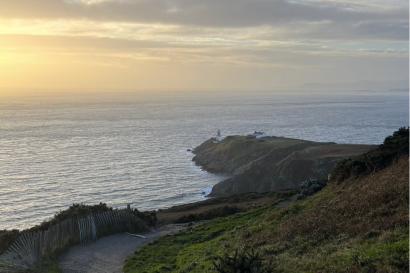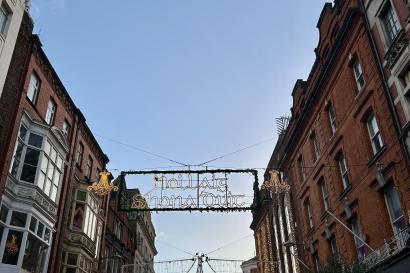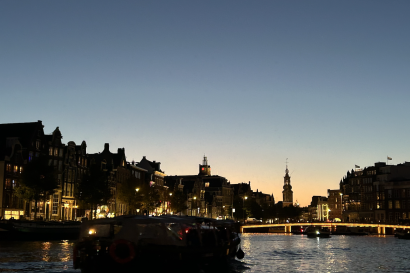When pondering study abroad, many students daydream most about the opportunities for travel. Often these visions are of long weekend trips to distant countries and far away cities. But discovering entirely new places doesn’t always have to mean going somewhere a plane or train ride away. Especially given the complications of traveling due to Covid, most of my traveling this semester has involved exploring other cities within my own host country of Spain. In fact, the majority of my trips have been to cities within a two hour bus ride of Madrid. This is in large part due to the numerous field trips organized throughout the semester by IES Abroad. Many Saturdays, my friends and I woke up early, rode the metro a few stops to the meeting point, and met up with other students before piling onto busses that would transport us to a new destination on the outskirts of Madrid. Below is a brief overview of some of the IES Abroad field trips, and a description of some of the most exciting spots and stories to discover in each town.
Segovia
About an hour's bus ride from Madrid, Segovia is a city in the autonomous community of Castile and León. Declared a world heritage site by UNESCO in 1985, the town is most famous for its gothic cathedral, ancient Roman aqueduct, and medieval castle (said to serve as inspiration for Walt Disney’s Cinderella’s Castle). The aqueduct, built during the 1st century AD, is nearly 100 feet tall and runs for 15 miles. The structure is a marvel of engineering, and incredibly well prepared. One of the most memorable moments of the trip is seeing the aqueduct for the first time, and climbing up the steps to the top.
Ávila
Ávila is most well known for the medieval walls that surround the entire city. Also a world heritage site, writer José Martínez Ruiz describes it as “perhaps the most 16th century town in Spain." On our trip, we were able to walk around half the circumference of the walls, and explore some of the many churches. If you visit, don’t forget to try Yemas, a candy/dessert made from egg yolk. They yielded mixed reviews among students, but are very traditional in this region.
Toledo
Well known as the “City of Three Cultures,” Toledo is one of the rare locations where Christians, Jews, and Muslims at one time peacefully coexisted within the same city walls. As such, many churches contain a fascinating mix of art and architecture from all three religions. The Cathedral of Toledo, built in the 13th century, is sometimes considered the most magnificent example of gothic architecture in Spain. In terms of local cuisine, be sure to try Toledo’s marzipan, a confection made from almonds and sugar. Many claim that this speciality originated here, as far back as 1150 under the reign of Alfonso VII.
Buitrago
Buitrago del Lozoya lies in the Sierra Norte Region of Spain, surrounded by mountains and located along the Lozoya river. This town is most famous for the preservation of its Moorish walls, which date back to the 11th century. Perhaps unexpectedly, this small town also contains a museum with works from Pablo Picasso. All the works are from the collection of Eugnio Arias, a barber from Buitrago who was close friends with the artist.
Aranjuez
Located 50 km south of Madrid, this city is most famous as the home to the Royal Palace of Aranjuez, a former Spanish royal residence. Established during the reign of Philip II, the Palace served as a seasonal home for many different members of the royal family. In my opinion, the most fascinating room is the Salón Árabe, decorated in a Neo-Nasrid style, recreating (with incredible detail) the architecture and design of the famous Alhambra in Granada, Spain. Also be sure to allow time for exploring the extensive gardens outside of the palace, particularly beautiful under the cover of colorful fall foliage.
El Escorial
The Royal Monastery of San Lorenzo de El Escorial is a massive complex that includes a palace, basilica, pantheon, library, school and monastery. Built in the 16th century, the building occupies over 300,000 square feet, including 16 patios, 9 towers, and 4,000 rooms. This remarkable Renaissance-style, multi-functional complex is widely considered the Eighth Wonder of the World. In touring the monastery, we viewed the basilica, crypt, bedroom of King Philip II, and incredible halls of artwork and paintings.

Kyla Hunter
<p>Hello! My name is Kyla Hunter and I am a rising junior at Duke University studying Mechanical Engineering, with a focus on Energy & Environment. Although I was born in Princeton, New Jersey, bouncing around between different states as a child was the beginning of my interest in exploring new settings and meeting new people. I have long dreamed of studying abroad and am thrilled to be participating in the IES - Engineering, Math & Science Program in Madrid this fall. On campus, I am a Residential Assistant for first-year students and a tour guide for the School of Engineering. In my free time, I can often be found drawing in my sketchbook or playing the piano in the common room. I look forward to sharing some of my experiences as I navigate new cultural, social, and academic endeavors in Spain!</p>








